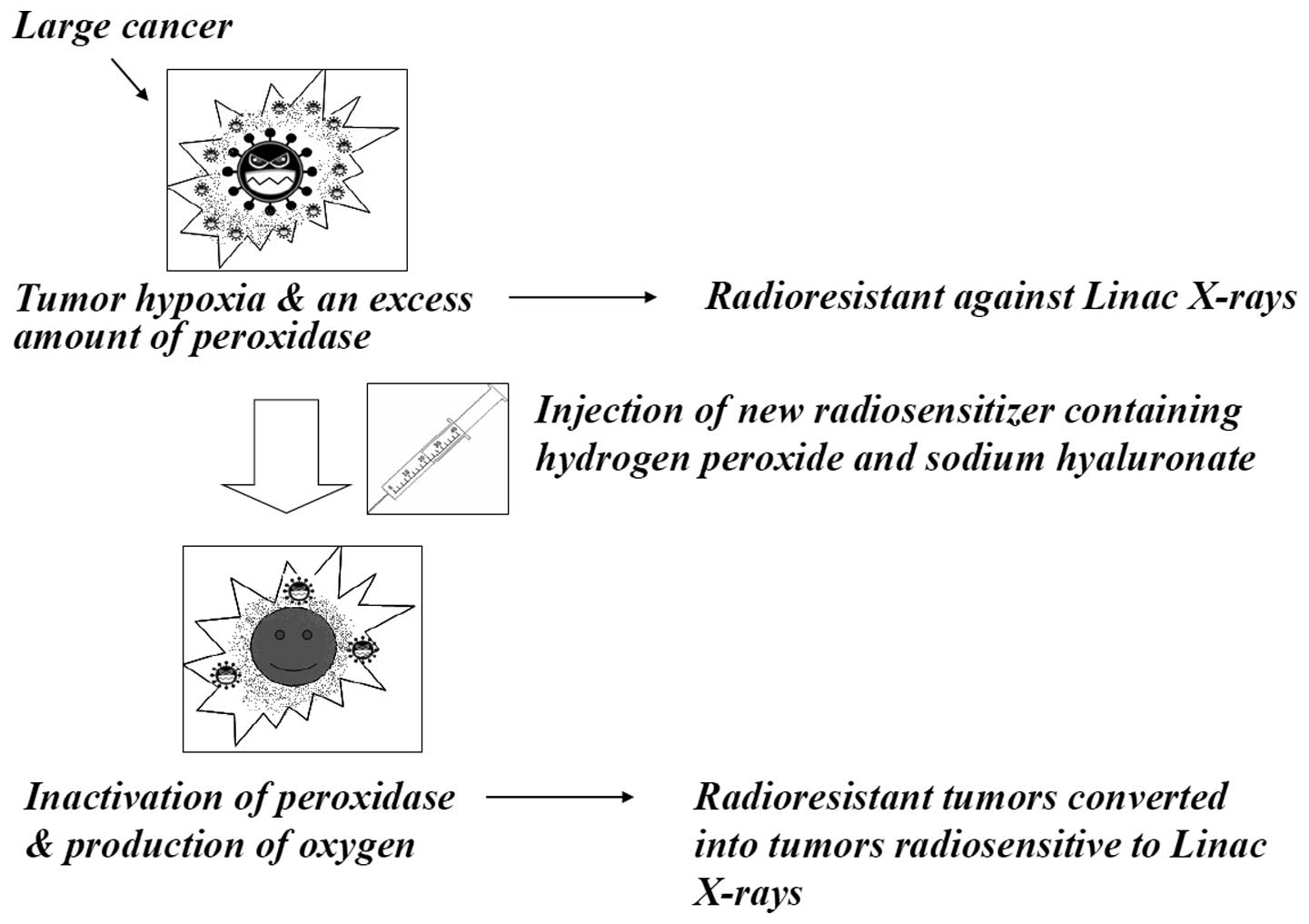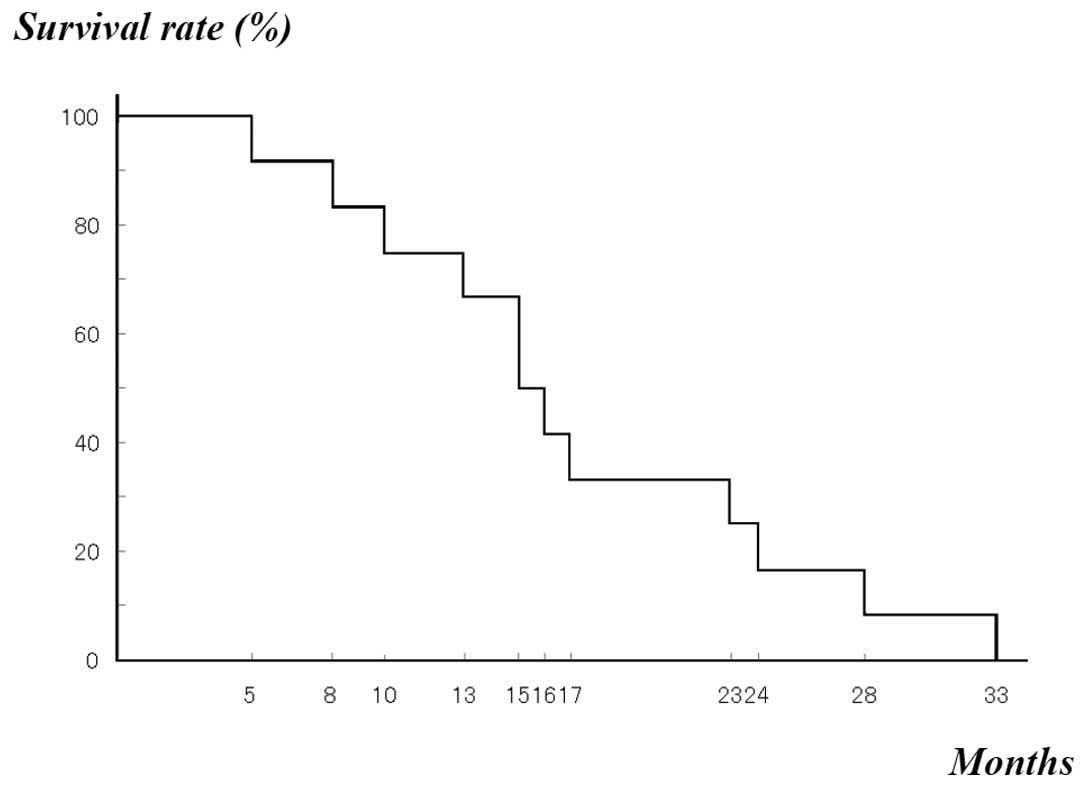|
1
|
Ogawa Y, Takahashi T, Kobayashi T, et al:
Mechanism of apoptotic resistance of human osteosarcoma cell line,
HS-Os-1, against irradiation. Int J Mol Med. 12:453–458. 2003.
|
|
2
|
Ogawa Y, Takahashi T, Kobayashi T, et al:
Apoptotic-resistance of the human osteosarcoma cell line HS-Os-1 to
irradiation is converted to apoptotic-susceptibility by hydrogen
peroxide: a potent role of hydrogen peroxide as a new
radiosensitizer. Int J Mol Med. 12:845–850. 2003.
|
|
3
|
Ogawa Y, Takahashi T, Kobayashi T, et al:
Immunocytochemical characteristics of human osteosarcoma cell line
HS-Os-1: possible implication in apoptotic resistance against
irradiation. Int J Mol Med. 14:397–403. 2004.
|
|
4
|
Kariya S, Sawada K, Kobayashi T, et al:
Combination treatment of hydrogen peroxide and X-rays induces
apoptosis in human prostate cancer PC-3 cells. Int J Radiat Oncol
Biol Phys. 75:449–454. 2009.
|
|
5
|
Ogawa Y, Ue H, Tsuzuki K, et al: New
radiosensitization treatment (KORTUC I) using hydrogen peroxide
solution-soaked gauze bolus for unresectable and superficially
exposed neoplasms. Oncol Rep. 19:1389–1394. 2008.
|
|
6
|
Ogawa Y, Kubota K, Ue H, et al: Phase I
study of a new radiosensitizer containing hydrogen peroxide and
sodium hyaluronate for topical tumor injection: a new
enzyme-targeting radiosensitization treatment, Kochi
Oxydol-Radiation Therapy for Unresectable Carcinomas, Type II
(KORTUC II). Int J Oncol. 34:609–618. 2009.
|
|
7
|
Miyatake K, Kubota K, Ogawa Y, et al:
Non-surgical care for locally advanced breast cancer:
radiologically assessed therapeutic outcome of a new
enzyme-targeting radiosensitization treatment, Kochi
Oxydol-Radiation Therapy for Unresectable Carcinomas, Type II
(KORTUC II) with systemic chemotherapy. Oncol Rep. 24:1161–1168.
2010.
|
|
8
|
Ogawa Y, Kubota K, Ue H, et al: Safety and
effectiveness of a new enzyme-targeting radiosensitization
treatment (KORTUC II) for intratumoral injection for low-LET
radioresistant tumors. Int J Oncol. 39:553–560. 2011.
|
|
9
|
Parkin DM, Bray F, Ferlay J, et al: Global
cancer statistics, 2002. CA Cancer J Clin. 55:74–108. 2005.
|
|
10
|
Jemal A, Siegel R, Ward E, et al: Cancer
statistics, 2008. CA Cancer J Clin. 58:71–96. 2008.
|
|
11
|
Philip PA, Mooney M, Jaffe D, et al:
Consensus report of the national cancer institute clinical trials
planning meeting on pancreas cancer treatment. J Clin Oncol.
27:5660–5669. 2009.
|
|
12
|
Burris HA III, Moore MJ, Andersen J, et
al: Improvements in survival and clinical benefit with gemcitabine
as first-line therapy for patients with advanced pancreas cancer: a
randomized trial. J Clin Oncol. 15:2403–2413. 1997.
|
|
13
|
Yamaguchi K, Nakamura K, Kobayashi K, et
al: ERT following IORT improves survival of patients with
respectable pancreatic cancer. Hepatogastroenterology.
52:1244–1249. 2005.
|
|
14
|
Ruano-Ravina A, Almazán Ortega R and
Guedea F: Intraoperative radiotherapy in pancreatic cancer: a
systematic review. Radiother Oncol. 87:318–325. 2008.
|
|
15
|
Shirasaka T, Shimamato Y, Ohshimo H, et
al: Development of a novel form of an oral 5-fluorouracil
derivative (S-1) directed to the potentiation of the tumor
selective cytotoxicity of 5-fluorouracil by two biochemical
modulators. Anticancer Drugs. 7:548–557. 1996.
|
|
16
|
Therasse P, Arbuck SG, Eisenhauer EA, et
al: New guidelines to evaluate the response to treatment in solid
tumors. European Organization for Research and Treatment of Cancer,
National Cancer Institute of the United States, National Cancer
Institute of Canada. J Natl Cancer Inst. 92:205–216. 2000.
|
|
17
|
Jette DC, Wiebe LI and Chapman JD:
Synthesis and in vivo studies of the radiosensitizer
4-[82Br]bromomisonidazole. Int J Nucl Med Biol. 10:205–210.
1983.
|
|
18
|
Coleman CN: Hypoxic cell radiosensitizers:
expectations and progress in drug development. Int J Radiat Oncol
Biol Phys. 11:323–329. 1985.
|
|
19
|
Hall EJ: Oxygen effect and reoxygenation.
Radiobiology for the Radiologist. Hall EJ: 5th edition. J.B.
Lippincott Co; Philadelphia, PA: pp. 91–111. 2000
|
|
20
|
Lawrence TS, Blackstock AW and McGinn C:
The mechanism of action of radiosensitization of conventional
chemotherapeutic agents. Semin Radiat Oncol. 13:13–21. 2003.
|
|
21
|
Choy H and Milas L: Enhancing radiotherapy
with cyclooxygenase-2 enzyme inhibitors: a rational advance? J Natl
Cancer Inst. 95:1440–1452. 2003.
|
|
22
|
Overgaad J: Clinical evaluation of
nitroimidazoles as modifiers of hypoxia in solid tumors. Oncol Res.
6:509–518. 1994.
|
|
23
|
O’Connor JK, Sause WT, Hazard LJ, et al:
Survival after attempted surgical resection and intraoperative
radiation therapy for pancreatic and periampllary adenocarcinoma.
Int J Radiat Oncol Biol Phys. 63:1060–1066. 2005.
|
|
24
|
Ma HB, Di ZL, Wang XJ, et al: Effect of
intraoperative radiotherapy combined with external beam
radiotherapy following internal drainage for advanced pancreatic
cancer. World J Gastroenterol. 10:1669–1771. 2004.
|
|
25
|
Furuse J, Kinoshita T, Kawashima M, et al:
Intraoperative and conformal external-beam radiation therapy with
protracted 5-fluorouracil infusion in patients with locally
advanced pancreatic carcinoma. Cancer. 97:1346–1352. 2003.
|
|
26
|
Ogawa K, Karasawa K, Ito Y, et al; JROSG
Working Subgroup of Gastrointestinal Cancers. Intraoperative
radiotherapy for unresectable pancreatic cancer: a
multi-institutional retrospective analysis of 144 patients. Int J
Radiat Oncol Biol Phys. 80:111–118. 2011.
|
|
27
|
Sunamura M, Karasawa K, Okamoto A, et al;
PR-350 study group. Phase III trial of radiosensitizer PR-350
combined with intraoperative radiotherapy for the treatment of
locally advanced pancreatic cancer. Pancreas. 28:330–334. 2004.
|











